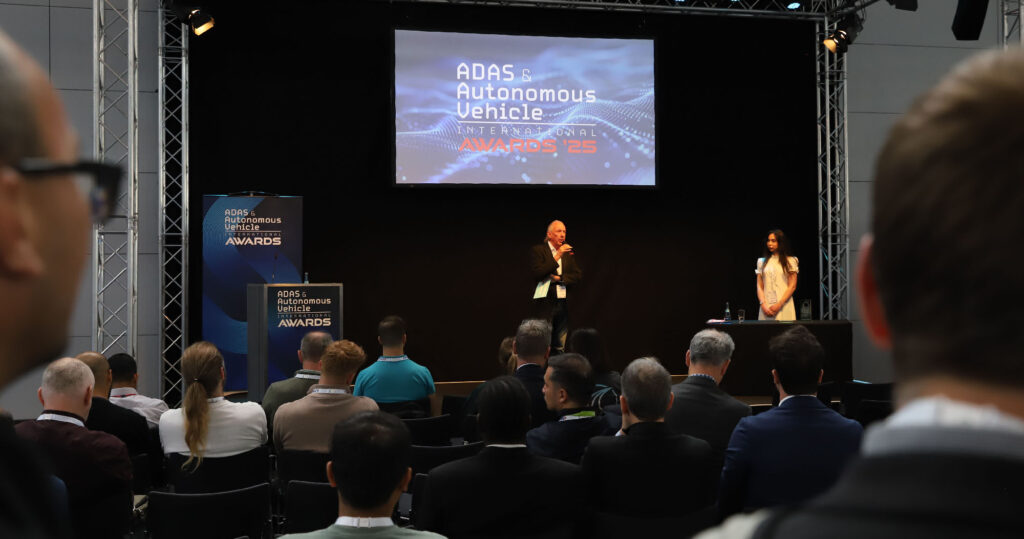A brand-new awards ceremony recognizing the innovations and technologies shaping the future of advanced driver-assistance systems and autonomous vehicles took place today, May 21, at ADAS & Autonomous Vehicle Technology Expo in Stuttgart, Germany.
Coordinated by ADAS & Autonomous Vehicle International (AAVI) magazine, the awards celebrate the very best innovations and new technologies across the ADAS and autonomous mobility sector during the last 18 months, acknowledging the achievements of the most remarkable projects and companies.
The awards are officiated by a panel of international industry experts who put forward their nominations for each of the eight categories, with the final winners then chosen by AAVI’s international subscribers. “At a critical juncture for the automotive and transportation sectors, these awards honor the hard-working engineering teams behind the most noteworthy achievements that are driving safer, smarter and more sustainable mobility solutions,” commented AAVI’s editor, Anthony James.
Vehicle Deployment of the Year
The first trophy went to Waymo One, which provides more than 250,000 paid trips each week across Phoenix, San Francisco, Los Angeles and Austin, with fully autonomous ride-hailing in Atlanta, Miami and Washington DC set to begin in 2026. “Having achieved 20x growth in less than two years, Waymo has also recently announced a new Arizona-based vehicle production facility in partnership with Magna, which, when operating at full capacity, will be capable of building tens of thousands of fully autonomous Waymo vehicles per year,” noted James.
Safety Innovation of the Year
Safety Cloud by HAAS Alert was the next winner to be announced. The Safety Cloud platform connects passenger and commercial vehicles to a global network of emergency vehicles, infrastructure and unexpected roadway hazards, notifying drivers to slow down and move over to protect roadway workers and first responders. “Already integrated into Stellantis and Volkswagen vehicles in North America, this solution continues to go from strength to strength, with more recent customers including UK road construction groups and central European road operators, as well as US emergency services providers,” commented James.
Collaboration of the Year
ASAM OpenX, which has seen hundreds of industry professionals within ASAM come together over the past seven years to work on simulation standards, picked up the Collaboration of the Year award. OpenX is the collective name for the standards in the ASAM simulation domain. It comprises data formats, languages and data models that are required to describe virtual environments. “Starting from highly detailed road surfaces, it goes via road logics to the very actions of traffic participants in the respective scenarios,” said James. “It generalizes the data communication between sensor models and the respective ADAS/AD functions, and defines how materials and 3D objects have to be described in a way that can be understood by the majority of tools in the market.”
In-cabin Innovation of the Year
Novelic’s Automotive In-cabin Monitoring (ACAM) 60GHz millimeter-wave smart contactless sensor, which can detect and monitor living beings inside a vehicle, took first place in the In-Cabin Innovation category. When combined with the company’s perception software stack, the radar sensor enables in-cabin monitoring with full interior coverage. “ACAM can be equipped with different signal processing software packages to cover a wide range of in-cabin applications, including child presence detection, for which Euro NCAP will reward passenger vehicles up to five points, starting in 2026,” said James.
Engineering Team of the Year
The engineering team at MAN Truck & Bus was the next winner announced, in recognition of the truck manufacturer’s decision to openly share valuable datasets in a bid to accelerate the development of autonomous driving. MAN TruckScenes features sensor and vehicle data from over 700 scenarios captured during MAN’s real-world development drives for autonomous driving. “This data release not only promotes the standardization of data formats between different players, such as manufacturers, universities and software developers, but also enables a standardized comparison of results and methods as a reference for scientific studies, while simplifying collaboration with external development partners,” said James.

Public Awareness Campaign of the Year
In 2024, Euro NCAP took a bold new step in road safety with the launch of its Safer Trucks program. For the first time, heavy goods vehicles are being assessed with the same independence and transparency that Euro NCAP is known for in passenger cars. The first results, published last November, marked a turning point, giving fleet operators, manufacturers and regulators a clear benchmark for safer, smarter trucks. “AAVI’s readers have chosen to recognize Euro NCAP’s contribution toward achieving Vision Zero [zero accidents for all road users], which requires not only passenger cars but all vehicles to comply with the highest safety standards.”
Disruptor of the Year
Founded in 2017, British AI company Wayve is a pioneer in embodied AI for autonomous driving, having been the first to develop and test an end-to-end (e2e) deep learning autonomous driving system on public roads. Today, the company is building foundation models for autonomy, similar to a ‘GPT for driving’, which can empower any vehicle to see, think and drive through any environment. Its AI adapts seamlessly across countries and vehicles, paving the way for scalable, autonomous driving without extensive reengineering. “Having recently opened a testing and development center in Japan, Wayve has also officially partnered with Nissan, as well as expanded its operations to Germany – this is a disruptor with the potential to become part of the mainstream,” commented James.
Startup of the year
Perciv AI, which positions itself as the world’s first dedicated AI for radar perception, promising lidar-like performance at a fraction of the cost while staying hardware agnostic, picked up the Startup trophy. “Its radar processing SDK transforms standard automotive radars into high-resolution 3D sensors that let autonomous cars, trucks, tractors, drones and robots understand their surroundings in rain, fog or darkness, closing the performance gap between low-cost radar and more expensive lidar systems,” said James.
Click here to learn more about the awards.


